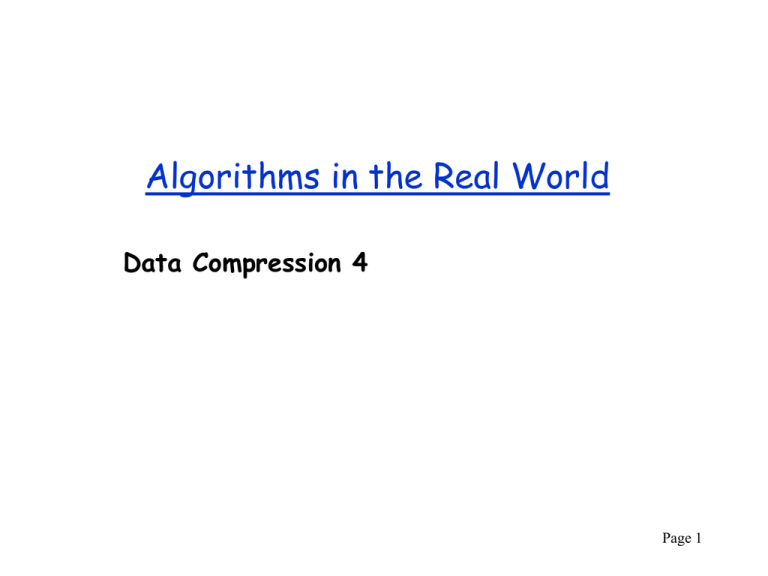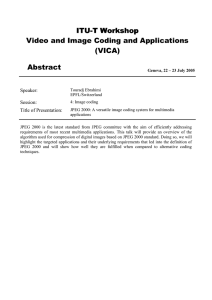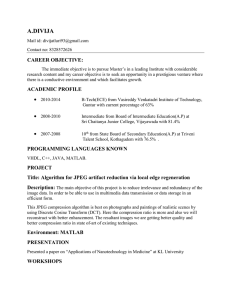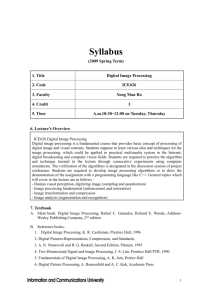Algorithms in the Real World Data Compression 4 Page 1
advertisement

Algorithms in the Real World Data Compression 4 Page 1 Compression Outline Introduction: Lossy vs. Lossless, Benchmarks, … Information Theory: Entropy, etc. Probability Coding: Huffman + Arithmetic Coding Applications of Probability Coding: PPM + others Lempel-Ziv Algorithms: LZ77, gzip, compress, … Other Lossless Algorithms: Burrows-Wheeler Lossy algorithms for images: JPEG, MPEG, ... – Scalar and vector quantization – JPEG and MPEG Compressing graphs and meshes: BBK 296.3 Page 2 Scalar Quantization Quantize regions of values into a single value: output output input uniform input non uniform Quantization is lossy Can be used, e.g., to reduce # of bits for a pixel Page 3 Vector Quantization: Example representative codevectors Input vectors are (Height, Weight) pairs. Map each input vector to a representative “codevector”. Codevectors are stored in a codebook. Page 4 Vector Quantization input output generate input vector generate output vector index of codevector compress index find closest codevector codebook encode codevector decompress index index codebook decode Page 5 Vector Quantization What do we use as vectors? • Color (Red, Green, Blue) – Can be used, for example to reduce 24bits/pixel to 12bits/pixel – Used in some terminals to reduce data rate from the CPU (colormaps) • k consecutive samples in audio • Block of k x k pixels in an image How do we decide on a codebook • Typically done with clustering Page 6 Linear Transform Coding Want to encode values over a region of time or space – typically used for images or audio – represented as a vector [x1,x2,…] Select a set of linear basis functions i that span the space – sin, cos, spherical harmonics, wavelets, … – defined at discrete points Page 7 Linear Transform Coding Coefficients: i x ji ( j ) x j aij j i i th j resulting coefficien t x j j input valu e aij ij th transform coefficien t i ( j ) th In matrix notation: Ax 1 xA Where A is an n x n matrix, and each row defines a basis function Page 8 Example: Cosine Transform 1 ( j ) 0 ( j ) 2 ( j ) … i xj j i x ji ( j ) j small values ? Page 9 Other Transforms Polynomial: 1 x x2 Wavelet (Haar): Page 10 How to Pick a Transform Goals: – Decorrelate (remove repeated patterns in data) – Low coefficients for many terms – Some terms affect perception more than others Why is using a Cosine or Fourier transform across a whole image bad? -- If there is no periodicity in the image, large coefficients for high-frequency terms How might we fix this? -- use basis functions that are not as smoothly periodic Page 11 Usefulness of Transform Typically transforms A are orthonormal: A-1 = AT Properties of orthonormal transforms: • x2 = 2 (energy conservation) Would like to compact energy into as few coefficients as possible 1 2 i n (the transform coding gain) GTC 1 2 n arithmetic mean/geometric mean i i = (i - av) The higher the gain, the better the compression Page 12 Case Study: JPEG A nice example since it uses many techniques: – Transform coding (Discrete Cosine Transform) – Scalar quantization – Difference coding – Run-length coding – Huffman or arithmetic coding JPEG (Joint Photographic Experts Group) was designed in 1991 for lossy and lossless compression of color or grayscale images. The lossless version is rarely used. Can be adjusted for compression ratio (typically 10:1) 296.3 Page 13 JPEG in a Nutshell original image three planes of 8-bit pixel values Brightness 0.59 Green + 0.30 Red + 0.11 Blue (two-dimensional DCT) interphase quadrature Typically downsample I and Q planes by a factor of 2 in each dimension – lossy. Factor of 4 compression for I and Q, 2 overall. break each plane into 8x8 blocks of pixels Page 14 JPEG: Quantization Table 16 11 10 16 24 40 51 61 12 12 14 19 26 58 60 55 14 13 16 24 40 57 69 56 14 17 22 29 51 87 80 62 18 22 37 56 68 109 103 77 24 35 55 64 81 104 113 92 49 64 78 87 103 121 120 101 72 92 95 98 112 100 103 99 Divide each coefficient by factor shown. Also divided through uniformly by a quality factor which is under control. Page 15 JPEG: Block scanning order • Scan block of coefficients in zig-zag order • Use difference coding upper left (DC) coefficient between consecutive blocks • Uses run-length coding for sequences of zeros for rest of block Page 16 JPEG: example .125 bits/pixel (factor of 192) Page 17 Case Study: MPEG Pretty much JPEG with interframe coding Three types of frames – I = intra frame (approx. JPEG) anchors – P = predictive coded frames – based on previous I or P frame in output order – B = bidirectionally predictive coded frames - based on next and/or previous I or P frames in output order ordered chronologically Example: in input Type: I B B P B B P B B P B Output Order: 1 3 4 2 6 7 5 9 10 8 12 13 11 I frames are used for random access. In the sequence, each B frame appears after any frame on which it depends. B I Page 18 MPEG matching between frames Page 19 MPEG: Compression Ratio 356 x 240 image Type I Size 18KB Compression 7/1 P B 6KB 2.5KB 20/1 50/1 Average 4.8KB 27/1 30 frames/sec x 4.8KB/frame x 8 bits/byte = 1.2 Mbits/sec + .25 Mbits/sec (stereo audio) HDTV has 15x more pixels = 18 Mbits/sec Page 20 MPEG in the “real world” • DVDs – Adds “encryption” and error correcting codes • Direct broadcast satellite • HDTV standard – Adds error correcting code on top • Storage Tech “Media Vault” – Stores 25,000 movies Encoding is much more expensive than decoding. Still requires special purpose hardware for high resolution and good compression. Page 21 Compression Summary How do we figure out the probabilities – Transformations that skew them • Guess value and code difference • Move to front for temporal locality • Run-length • Linear transforms (Cosine, Wavelet) • Renumber (graph compression) – Conditional probabilities • Neighboring context In practice one almost always uses a combination of techniques Page 22



